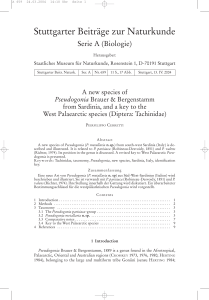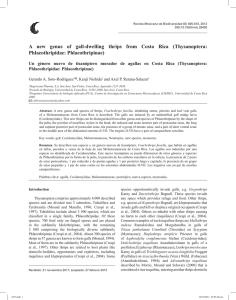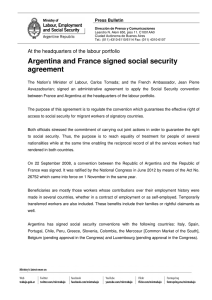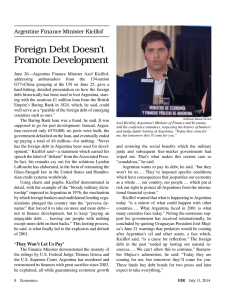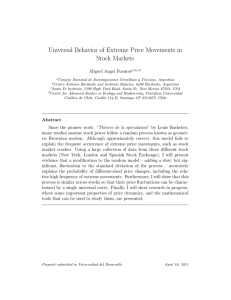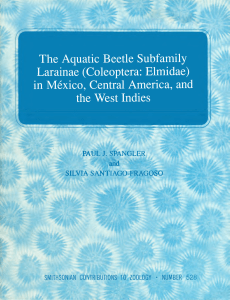Inglés
Anuncio
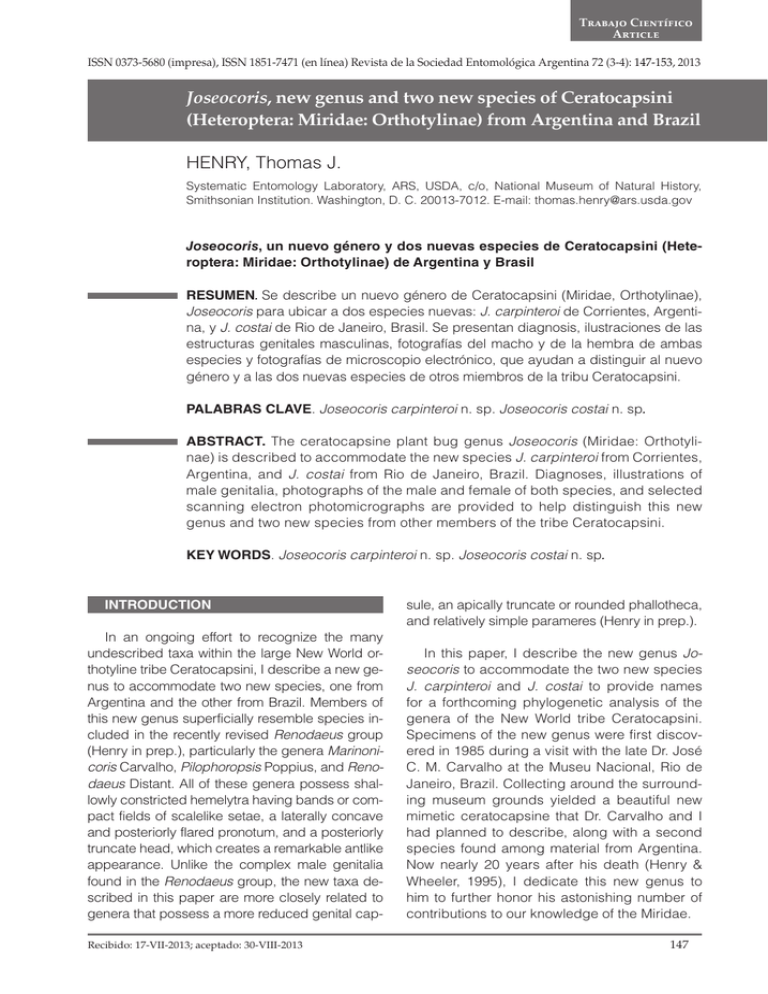
Trabajo Científico Article ISSN 0373-5680 (impresa), ISSN 1851-7471 (en línea) Revista de la Sociedad Entomológica Argentina 72 (3-4): 147-153, 2013 Joseocoris, new genus and two new species of Ceratocapsini (Heteroptera: Miridae: Orthotylinae) from Argentina and Brazil HENRY, Thomas J. Systematic Entomology Laboratory, ARS, USDA, c/o, National Museum of Natural History, Smithsonian Institution. Washington, D. C. 20013-7012. E-mail: [email protected] Joseocoris, un nuevo género y dos nuevas especies de Ceratocapsini (Heteroptera: Miridae: Orthotylinae) de Argentina y Brasil RESUMEN. Se describe un nuevo género de Ceratocapsini (Miridae, Orthotylinae), Joseocoris para ubicar a dos especies nuevas: J. carpinteroi de Corrientes, Argentina, y J. costai de Rio de Janeiro, Brasil. Se presentan diagnosis, ilustraciones de las estructuras genitales masculinas, fotografías del macho y de la hembra de ambas especies y fotografías de microscopio electrónico, que ayudan a distinguir al nuevo género y a las dos nuevas especies de otros miembros de la tribu Ceratocapsini. PALABRAS CLAVE. Joseocoris carpinteroi n. sp. Joseocoris costai n. sp. ABSTRACT. The ceratocapsine plant bug genus Joseocoris (Miridae: Orthotylinae) is described to accommodate the new species J. carpinteroi from Corrientes, Argentina, and J. costai from Rio de Janeiro, Brazil. Diagnoses, illustrations of male genitalia, photographs of the male and female of both species, and selected scanning electron photomicrographs are provided to help distinguish this new genus and two new species from other members of the tribe Ceratocapsini. KEY WORDS. Joseocoris carpinteroi n. sp. Joseocoris costai n. sp. INTRODUCTION In an ongoing effort to recognize the many undescribed taxa within the large New World orthotyline tribe Ceratocapsini, I describe a new genus to accommodate two new species, one from Argentina and the other from Brazil. Members of this new genus superficially resemble species included in the recently revised Renodaeus group (Henry in prep.), particularly the genera Marinonicoris Carvalho, Pilophoropsis Poppius, and Renodaeus Distant. All of these genera possess shallowly constricted hemelytra having bands or compact fields of scalelike setae, a laterally concave and posteriorly flared pronotum, and a posteriorly truncate head, which creates a remarkable antlike appearance. Unlike the complex male genitalia found in the Renodaeus group, the new taxa described in this paper are more closely related to genera that possess a more reduced genital capRecibido: 17-VII-2013; aceptado: 30-VIII-2013 sule, an apically truncate or rounded phallotheca, and relatively simple parameres (Henry in prep.). In this paper, I describe the new genus Joseocoris to accommodate the two new species J. carpinteroi and J. costai to provide names for a forthcoming phylogenetic analysis of the genera of the New World tribe Ceratocapsini. Specimens of the new genus were first discovered in 1985 during a visit with the late Dr. José C. M. Carvalho at the Museu Nacional, Rio de Janeiro, Brazil. Collecting around the surrounding museum grounds yielded a beautiful new mimetic ceratocapsine that Dr. Carvalho and I had planned to describe, along with a second species found among material from Argentina. Now nearly 20 years after his death (Henry & Wheeler, 1995), I dedicate this new genus to him to further honor his astonishing number of contributions to our knowledge of the Miridae. 147 Revista de la Sociedad Entomológica Argentina 72 (3-4): 147-153, 2013 MATERIAL & METHODS The male genital capsule was dissected and placed in room-temperature 10% KOH solution until softened and cleared, after which it was rinsed in water and placed in a depression slide containing glycerol. The right and left parameres, phallotheca, and endosoma were dissected and pencil sketched using a Nikon E400 compound microscope and drawing tube. Final illustrations were digitally rendered using Adobe Photoshop CS4. Color images were captured using an EntoVision Imaging Suite that included a JVC KY-75 3CCD digital camera mounted to a Leica M16 zoom lens via a Leica z-step microscope stand. Multiple focal planes were merged using Cartograph 5.6.0 (Microvision Instruments, France) software. Photomicrographs were taken using a Zeiss EVO/MA15 scanning electron microscope. Specimens were glued to standard SEM stubs, sputter coated, and examined at 6–10 KV. The color habitus plates, SEM photomicrographs, and male genitalia were prepared using Adobe Photoshop CS4 and numbered in Adobe Illustrator CS4. The following abbreviations are used for lending institutions cited in this paper: MACN: División Entomología, Museo Argentino de Ciencias Naturales “Bernardino Rivadavia,” Buenos Aires, Argentina; D. L. Carpintero. MNRJ: Museu Nacional, Rio de Janeiro, Brazil; L. A. A. Costa. USNM: National Museum of Natural History (USNM), Smithsonian Institution, Washington, DC, USA; T. J. Henry. RESULTS Joseocoris Henry, new genus Type species: Joseocoris costai Henry, new species. Diagnosis. This new genus is distinguished by the combination of the apically thickened antennal segments (narrow at base and gradually thickening toward apex); the pronotum narrowed at the middle and flared at the humeral angles; the hemelytra constricted at the bases near the level with the apex of the scutellum; the thickly set, silvery and golden scalelike setae on 148 the clavus, the basal two thirds of the corium, and along the basal edge of the costa, sparsely intermixed with long, erect, bristlelike setae; the sexual dimorphism (males macropterous, females submacropterous); and the male genitalia with a simple and apically rounded phallotheca and an L-shaped left paramere. Joseocoris differs from all other genera of Ceratocapsini by the silvery, scalelike setae intermixed with patches of golden scalelike setae on the basal 1/3 of the clavus and corium, and the reduced structure of the male genitalia. Within the tribe, only species within the genera Marinonicoris and Renodaeus have golden scalelike setae on the hemelytra; the male genitalia, however, place this new genus among the basal clades within the tribe (Henry in prep.). Description. Body elongate, hemelytra narrowed at level with scutellum and widened at level across cuneal fracture; each hemelytron with three types of setae: golden and silvery scalelike; long, erect, bristlelike; and short simple. Head vertical, vertex smooth, posterior margin straight across or only slightly convex; frons rounded, eyes large, compressed, continuous posteriorly with pronotum. Labium extending to bases of hind coxae, segment I short, not extending beyond anterior edge of xyphus and almost completely encased within the bucculae. Antenna cylindrical, covered by short, simple setae, all segments narrow at base and gradually incrassate toward apex. Pronotum narrowed anteriorly behind head, strongly convex, humeral angles flared and rounded, posterior margin weakly convex, weakly indented or depressed just before posterior angle; collar narrow, flattened; calli weakly delimited. Mesoscutum covered by base of pronotum; scutellum equilateral, glabrous basally, covered with silvery scalelike setae distally. Hemelytron narrowed at level of scutellum, widened at level of cuneal fracture, clavus and basal two thirds of corium covered with scalelike setae, cuneus slightly longer than wide in males; membrane biareolate, fully macropterous in males, submacropterous with membrane slightly shortened in females. Propleura finely punctate, side of mesosternum finely punctate, but weakly rugose at middle; ostiolar evaporative area with a large, distinct auricle. Femora with erect setae on in- HENRY, T. J. Joseocoris, a new genus and two new species of Ceratocapsini from Argentina and Brazil. Figs. 1–5. Joseocoris spp. 1–2, J. carpinteroi. 1, adult male, dorsal aspect; 2, adult female, dorsal aspect; 3–5, J. costai. 3, adult male, dorsal aspect; 4, adult male, lateral aspect; 5, adult female, dorsal aspect. ner surface; tibiae with short, weak spines, short simple setae, and two rows of dark longitudinal granulations. Male genitalia: Left paramere Lshaped, right paramere L-shaped or elongate oval; endosoma simple, with or without a single nearly straight spiculum, enclosed in an irregular, apically rounded phallotheca. Etymology. This new genus is named in honor of the late Dr. José C. M. Carvalho for his many heteropterological contributions. Joseocoris carpinteroi Henry, new species (Figs. 1, 2, 10–12) Diagnosis. This new species is recognized by the dark brown maculae on the frons, the thickly set silvery and golden setae on the basal two thirds of the corium and clavus, intermixed with long, erect, bristlelike setae, and the male genitalia. Joseocoris carpinteroi is similar to J. costai, but can be distinguished by the dark 149 Revista de la Sociedad Entomológica Argentina 72 (3-4): 147-153, 2013 maculae on the frons, the thicker antennal segments, the lack of well-defined, cleared circular areas at the bases of the bristlelike hemelytral setae, and the male genitalia, especially the elongate-oval right paramere. Description. Male (Fig. 1) (n=2; plus holotype measurements in parentheses): Length from apex of clypeus to apex of hemelytral membrane 3.01–3.04 mm (3.14 mm), width across widest area of hemelytra 1.07–1.09 mm (1.20 mm). Head: Width 0.75–0.80 mm (0.78 mm), interocular width 0.22–0.26 mm (0.27 mm). Labium: Length 1.04 mm (1.06 mm), extending to bases of hind coxae. Antenna: Segment I, length 0.26–0.27 mm (0.24 mm); II, 0.56–0.58 mm (0.58 mm); III, 0.34 mm (0.32 mm); IV, missing on all specimens. Pronotum: Length 0.62–0.64 mm (0.69 mm), basal width 1.06 mm (1.07 mm). Color and texture: Head: Shiny brown, with opposing dark brown spots or maculae on interocular area and frons; base of clypeus darker brown; surface finely alutaceous, with a few fine brown-stained punctures on frons. Antenna: Uniformly brown. Pronotum: Uniformly dark shiny brown; densely covered with fine, brown-stained punctures, calli weakly raised and slightly less punctate. Scutellum: Basal third nearly impunctate, becoming more yellowish brown and densely punctate on distal two thirds. Hemelytron: Dark brown, with apex of clavus, base of cuneus, and area along base of costa becoming somewhat paler yellowish brown; clavus, base of cuneus, and basal two thirds of corium densely punctate, apical third of corium nearly impunctate. Vestiture: Head with mostly short, recumbent, simple setae and a few long, erect setae along basal area. Pronotum with numerous short, recumbent, simple setae, intermixed with scattered long, erect setae. Scutellum: Glabrous on basal third; densely covered with silvery, scalelike setae on distal two thirds. Hemelytron: Clavus and basal two thirds of corium thickly covered with silvery, scalelike setae; base of costal area along claval commissure and inner margin of clavus with golden scalelike setae, intermixed with long, erect, bristlelike setae on clavus and corium. Male genitalia: Left paramere (Fig. 10) Lshaped with apex of lateral arm truncate. Right 150 paramere (Fig. 11) elongate oval. Phallotheca (Fig. 12) irregularly rounded apically; endosoma simple with a distinct secondary gonopore and lacking a spiculum. Female (Fig. 2) (n=1): Length from apex of clypeus to apex of hemelytral membrane 2.83 mm, width across widest area of hemelytra 1.15 mm. Head: Width 0.70 mm, interocular width 0.32 mm. Labium: Obscured by glue under body. Antenna: Segment I, length 0.24 mm; II, 0.53 mm; III, 0.29 mm; IV, 0.34 mm. Pronotum: Length 0.59 mm, basal width 0.96 mm. Similar to male in color, texture, and vestiture, differing primarily in the broader overall body form and shorter hemelytral membrane. Host. Unknown. Distribution. Corrientes and Santiago del Estero, Argentina. Etymology. I name this interesting new species after Diego L. Carpintero (MACN) for his many contributions to the Heteroptera of Argentina, including his collections of most of the specimens of this new species. Type material. ARGENTINA. Santiago del Estero: Holotype ♂, Añatuya (Luz), Mar. 1999, D. L. Carpintero (MACN). Paratypes: same data as for holotype, 2 ♂♂ (MACN, USNM); Corrientes: Capital, July 1934, Bosq, 1 ♀ (MACN). Joseocoris costai Henry, new species (Figs. 3–9, 13–15) Diagnosis. This species is distinguished by the constricted hemelytra; the thick patches of silvery and golden scalelike setae on the basal two thirds of the corium and clavus, intermixed with long, erect, bristlelike setae having a circular, seta-free patch at the base of each; and the male genitalia, especially the L-shaped right and left parameres and the distinct simple spiculum on the endosoma. It is similar to J. carpinteroi in the overall antlike appearance and possession of silvery and golden scalelike setae on the hemelytra, but J. costai has a clear round area at the base of each bristlelike seta on the hemelytra, it lacks the dark maculae on the frons, and the male genitalia are distinct, particularly the L- HENRY, T. J. Joseocoris, a new genus and two new species of Ceratocapsini from Argentina and Brazil. Figs. 6–9. SEM micrographs of Joseocoris costai. 6, head and pronotum, lateral aspect; 7, ostiolar evaporative area; 8, scalelike and bristlelike setae on hemelytra; 9, claw. shaped left and right parameres and endosoma having a simple spiculum. Description. Male (Figs. 3, 4) (n=3; plus holotype measurements in parentheses): Length from apex of clypeus to apex of hemelytral membrane 2.75–2.83 mm (2.75 mm), width across widest area of hemelytra 0.86–0.91 mm (0.90 mm). Head: Width 0.67 mm (0.69 mm), interocular width 0.22 mm (0.22 mm). Labium: Length 0.91– 0.96 mm (0.96 mm), extending to bases of hind coxae. Antenna: Segment I, length 0.19–0.21 mm (0.21 mm); II, 0.59 mm (0.61 mm); III, 0.32–0.35 mm (0.34 mm); IV, 0.30–0.32 mm (0.32 mm). Pronotum: Length 0.59 mm (0.61mm), basal width 0.85–0.86 mm (0.88 mm). Coloration and texture: Head (Fig. 6): Dark shiny brown, more yellowish brown anteriorly toward clypeus; vertex and frons with evenly scattered dark-stained punctures. Antenna: Uniformly dark brown. Pronotum: Dark shiny brown, becoming more yellowish brown on anterior half; calli slightly raised, impunctate; narrow anterior area before collar thickly and finely punctate; disc evenly scattered with fine dark-stained punctures. Scutellum: Shiny dark brown, more yellowish brown on apical third. Hemelyron: Shiny dark brown, inner basal two thirds of clavus yellowish brown; deeply punctate on clavus and basal halves of corium and cuneus; membrane smoky brown, paler at base. Ventral surface: Thorax and abdomen uniformly shiny dark brown. Ostiolar evaporative area (Fig. 7): White. Legs: Fore coxae brown, middle and hind coxae pallid or whitish with bases brown; femora and tibia dark brown; tarsi and claws (Fig. 9) more yellowish brown. Vestiture: Head and pronotum with long, erect and semierect simple setae, intermixed with short, recumbent simple setae. Scutellum: Basal third glabrous; distal two thirds thickly covered with silvery, scalelike setae. Hemelytron (Fig. 8): Clavus and basal two thirds of corium thickly covered with silvery, scalelike setae, with golden scalelike setae on base of costal area along claval commissure and inner margin of clavus, intermixed with long, erect, bristlelike 151 Revista de la Sociedad Entomológica Argentina 72 (3-4): 147-153, 2013 Figs. 10–15. Male genitalia of Joseocoris spp. 10–12, J. carpinteroi. 10, left paramere; 11, right paramere; 12, phallotheca and endosoma; 13–15, J. costai. 13, left paramere; 14, right paramere; 15, phallotheca and endosoma. setae on clavus and corium, with the bases of most encircled by a clear seta-free area. Male genitalia: Left paramere (Fig. 13) Lshaped or boot-shaped with apex of lateral arm truncate. Right paramere (Fig. 14) L-shaped with lateral arm curved downward and pointed at apex. Phallotheca (Fig. 15) irregularly round152 ed apically; endosoma simple with distinct secondary gonopore and a single, straight, spiculum, only slightly curving at the apex. Female (Fig. 5) (n=5): Length from apex of clypeus to apex of hemelytral membrane 2.43– 2.50 mm, width across widest area of hemelytra 0.98–1.01 mm. Head: Width 0.61–0.62 mm, in- HENRY, T. J. Joseocoris, a new genus and two new species of Ceratocapsini from Argentina and Brazil. terocular width 0.24–0.27 mm. Labium: Length 0.90–0.98 mm. Antenna: Length segment I 0.19–0.21 mm; II, 0.54–0.56 mm; III, 0.30–0.32 mm; IV, 0.30 mm. Pronotum: Length 0.56–0.59 mm, basal width 0.77–0.78 mm. Similar to male in color, texture, and vestiture, differing in the proportionately broader body form and slightly abbreviated hemelytral membrane that extends from the apex of the abdomen or only slightly beyond. Host. Beaten from a small, unknown, opengrowing tree on Museum grounds. Distribution. Rio de Janeiro, Brazil. Etymology. I name this interesting new species after Luis A. A. Costa, who has contributed to our knowledge of the Miridae through his numerous publications and many outstanding habitus and genitalic illustrations. Type material. BRAZIL. R[io de]J[aneiro]: Holotype ♂, Quinta Boa Vista, XII-85, Menezes col. [1st male in series labeled by me as holotype-genitalia dissected and glued to separate point] (MNRJ). Paratypes: same data as for holotype, 2 ♂♂, 3 ♀♀ (MNRJ); R[io de]J[aneiro]: Quinta Boa Vista, XI-85, J. C. M. Carvalho, 3 ♂♂, 2 ♀♀ (MNRJ); Rio de Janeiro: Brazil, Horto Botanica, Quinta Boa Vista, 28-31 Oct. 1985, T. J. Henry, 3 ♂♂, 7 ♀♀ (USNM). ACKNOWLEDGMENTS I am grateful to Diego Carpintero (MACN) and Luiz A. A. Costa (MNRJ) for lending specimens, M. Cecilia Melo (Instituto de Limnología “R.A. Ringuelet,” La Plata, Argentina) for preparing the Spanish abstract, Michele Touchet (Systematic Entomology Laboratory, Agricultural Research Service, United States Department of Agriculture, c/o USNM) for the color photographs, Karie Darrow (Smithsonian Institution [SI], Washington, DC) for rendering the genitalic illustrations, and Scott Whitaker (SI) for assistance in the SEM Laboratory, including coating specimens. M. D. Schwartz (Agriculture & Agri-Food Canada, Ottawa, Ontario) and A. G. Wheeler, Jr. (Clemson University, Clemson, South Carolina, USA) kindly reviewed the manuscript and offered useful suggestions for its improvement. The USDA is an equal opportunity employer. LITERATURE CITED HENRY, T. J. & A. G. WHEELER, JR. (eds.). 1995. Contributions on Heteroptera dedicated to the memory of José Candido de Melo Carvalho. Proceedings of the Entomological Society of Washington 97: 229–480. 153

